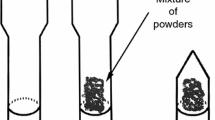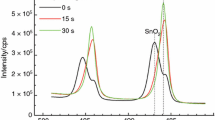Abstract
The present study deals with chemical reactions and enthalpies during the synthesis of Cu2ZnSnSe4 (CZTSe) from CuSe, SnSe, and ZnSe in molten NaI as flux material in closed degassed ampoules. Differential thermal analysis (DTA) at heating rates 5 °C min−1 and cooling rates 10 °C min−1 were used for the determination of temperatures of phase transitions and/or chemical reactions. XRD and Raman analyses confirmed that the formation of CZTSe starts already at 380 °C after the melting of Se that deliberates from the transformation of CuSe to Cu1.8Se, and the CZTSe formation process impedes to a great extent due to the presence of solid NaI. After the melting of NaI, the formation of CZTSe is completed. For the determination of enthalpy values, the calibration with pure NaI was performed. The thermal effects and enthalpies were compared with the available known thermodynamical values. The specific enthalpy of exothermic Cu2ZnSnSe4 formation at 661 °C in NaI −36 ± 3 kJ mol−1 was determined experimentally for the first time. Ternary compound Na2SnSe3 was formed during the synthesis process. NaI·2H2O, if present in NaI, was found to be a critical issue in the synthesis process of CZTSe monograin powders in molten NaI—it gave rise to the formation of oxygen-containing by-products Na2SeO4 and Na2Cu(OH)4. The complete dehydration of NaI·2H2O at T ≤ 70 °C in vacuum is necessary to avoid the formation of oxygen-containing compounds.





Similar content being viewed by others
References
Wang W, Winkler MT, Gunawan O, Gokmen T, Todorov TK, Zhu Y, Mitzi DB. Device characteristics of CZTSSe thin-film solar cells with 12.6% efficiency. Advanced Energy Materials. 2013; doi:10.1002/aenm.201301465.
Mellikov E, Hiie J, Altosaar M. Powder materials and technologies for solar cells. Int J Mater Prod Technol. 2007;28:291–311.
Timmo K, Altosaar M, Raudoja J, Muska K, Pilvet M, Kauk M, Varema T, Danilson M, Volobujeva O, Mellikov E. Sulfur-containing Cu2ZnSnSe4 monograin powders for solar cells. Sol Energy Mater Sol Cells. 2010;94:1889–92.
Altosaar M, Raudoja J, Timmo K, Danilson M, Grossberg M, Krustok J, Mellikov E. Chemical etching of Cu2ZnSn(S, Se)4 monograin powder. Phus Stat Sol. 2008;205:167–70.
Klavina I, Raudoja J, Altosaar M, Mellikov E, Meissner D. CZTSe (Cu2ZnSnSe4) crystal growth for use in monograin membrane solar cells. CYSENI 2010. In: Proceeding of the annual conference of young scientists on energy issues. [CD VII-347-VII-353]. Kaunas: Lithuanian Energy Institute. 2010 May 27–28.
Klavina I, Kaljuvee T, Timmo K, Raudoja J, Traksmaa R, Altosaar M, Meissner D. Study of Cu2ZnSnSe4 monograin formation in molten KI starting from binary chalcogenides. Thin Solid Films. 2011;519:7399–402.
Sofronov DS, Grinyov BV, Voloshko AY, Gerasimow VG, Kisil EM, Smirnov NN, Shishkin OV. Origin of the thermal desorption peaks of gases in NaI above 180°C. Inorg Mater. 2009;45:1314–8.
Digemans P. Dehydration of the alkali metal iodides in vacuum. Rec Trav Chim. 1938;57:144.
Li D. Fast and mass synthesis of ZnS nanosheet via ultra-strong surface interaction. Cryst Eng Comm. 2013; doi:10.1039/C3CE41529E.
Glazov V, Pashinkin A, Fedorov V. Phase equilibria in the Cu-Se system. Inorg Mater. 2000;36:641–52.
Xue C, Papadimitriou D, Raptis YS, Richter W, Esser N, Siebentritt S, Lux-Steiner MC. Micro-Raman study of orientation effects of CuxSe-crystallites on Cu-rich CuGaSe2 thin films. J Appl Phys 2004; doi:10.1063/1.1772885.
Barin I. Thermochemical data of pure substances. Part I. Weinheim: VCH Verlags Gesellschaft; 1993.
Barin I. Thermochemical data of pure substances. Part II. Weinheim: VCH Verlags Gesellschaft; 1993.
Glushko. Thermocenter of the Russian Academy of Sciences. Moscow, Russia: IVTAN Association, Izhorskaya; 1996.
Lucovsky G, Mikkelsen JC, Liang WY, White RM, Martin RM. Phys Rev. 1976;14:1663–9.
Barin I, Knacke O, Kubaschewski O. Thermochemical properties of inorganic substances. Berlin: Supplement, Springer-Verlag; 1977.
Barin I. Thermodynamical data of pure substances. Weinheim: VCH Verlags Gesellschaft; 1989.
Landolt-Börnstein. Thermodynamic properties of inorganic material. Scientific Group Thermodata Europe (SGTE). Berlin-Heidelberg: Springer-Verlag; 1999.
Marcano G, Rincon C, Lopez SA, Sanchez-Perez G, Herrera-Perez JL, Mendoza-Alvarez JG, Rodriguez P. Raman spectrum of monoclinic semiconductor Cu2SnSe3. Solid State Commun. 2011;151:84–6.
Arendt RH. J. Alternate fabrication process for molten carbonate fuel cell electrolyte structures. Solid State Chem. 1973;8:339.
Perna G, Lastella M, Ambroco M, Cappozzi V. Temperature dependence of the optical properties of ZnSe films deposited on quartz substrate. Appl Phus A. 2006;83:127–30.
Smith AJ, Meek PE, Liang WY, Raman J. Scattering studies of SnS2 and SnSe2. Phys C. 1977;10:1321.
Riou A, Cudennec Y, Gerault Y. Acta Cryst. 1989;45:374–6.
Dudchak I, Piskach L. Phase equilibria in the Cu2SnSe3-SnSe2-ZnSe system. J Alloy Compd. 2003;351:145–50.
Rapaport E, Pistorius CWFT. Phys Rew 1968;172:838.
Nakamura S, Maeda T, Tabata T, Wada T. First-principles study of indium-free photovoltaic compounds Ag2ZnSnSe4 and Cu2ZnSnSe4. In: Proceeding of the 37th IEEE photovoltaic specialist conference (Washington State Convention Center, Seattle, Washington, USA) 2011:785–786.
Grossberg M, Krustok J, Raudoja J, Timmo K, Altosaar M, Raadik T. Photoluminescence and Raman study of Cu2ZnSn(SexS1 – x)4 monograins for photovoltaic applications. Thin Solid Films. 2011;519:7403–6.
Kaufman B, Fang Y. Purification of Copper(I) Iodide. Inorg Synth. 1983;22:101–3.
Acknowledgements
The Doctoral Studies and Internationalization Program DoRa of the European Social Funds supported this research; Estonian Science Foundation grants 9425, 8964, G8964, projects TK117T, National R&D programs AR10128 and AR12128, the Estonian Ministry of Education and Research Contract No. SF0140099s08, and the EAS project EU29713. Support in the sample preparation process by Sergei Bereznev is gratefully acknowledged.
Author information
Authors and Affiliations
Corresponding author
Rights and permissions
About this article
Cite this article
Leinemann, I., Zhang, W., Kaljuvee, T. et al. Cu2ZnSnSe4 formation and reaction enthalpies in molten NaI starting from binary chalcogenides. J Therm Anal Calorim 118, 1313–1321 (2014). https://doi.org/10.1007/s10973-014-4102-y
Received:
Accepted:
Published:
Issue Date:
DOI: https://doi.org/10.1007/s10973-014-4102-y




